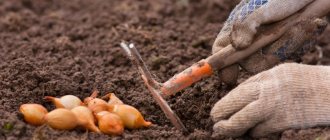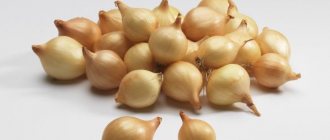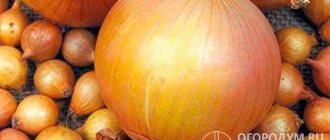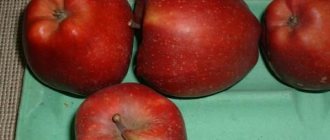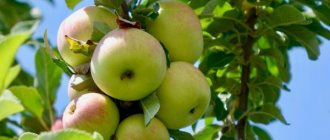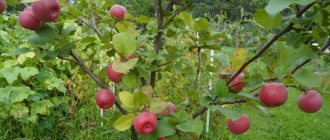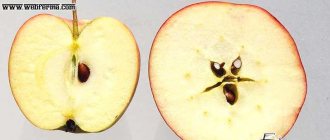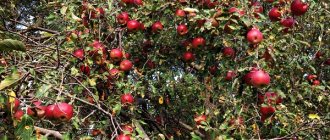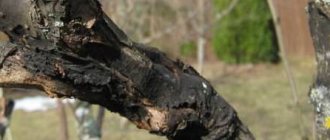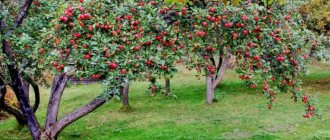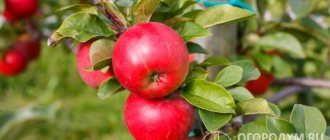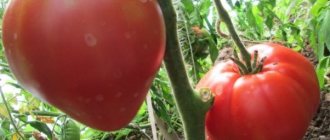Apple tree Freshness
The freshness was obtained by breeding scientists (E.N. Sedov, V.V. Zhdanov, Z.M. Serova) of the All-Russian Research Institute for Breeding Fruit Crops by hybridizing the parents of Antonovka red flank and Welsey.
It embodied their best characteristics, and in some respects even surpassed them.
In 1995, the variety was included in the State testing in the Central Black Earth and Central regions, and already in 2001 it was included in the State Register.
Important! Despite the fact that the variety can be called the newest, it has already gained admirers and admirers due to its ease of care, early fruiting and abundant tasty harvest.
Peculiarities
One of the important features of the variety is its amazing resistance to scab , which is due to the presence of a gene immune to this disease. This greatly facilitates the work of gardeners, simplifying tree care.
Morphology of tree and crown
Apple trees of the Fresh variety are characterized by rapid growth rates ; they reach a height of 3–4 m and are classified as medium-sized.
Apple tree Freshness grows up to 3-4 meters.
The crown is spherical, dense but compact, made up of branches of medium thickness extending from the trunk at an acute angle. The shoots are geniculate, round in cross-section, pubescence is visible on the upper part.
The leaves are ovoid, large and wide, deep emerald in color, slightly curled at the end. The leaf blade is glossy and wrinkled. The flowers are smooth, medium-sized, white with a pink tint.
Lifespan
An apple tree can live and bear fruit for a long time; experts indicate an approximate period of 60 years , which can be slightly extended by rejuvenating the shoots.
Productivity
The group of breeders who worked on the variety and its testing indicates the yield of the Fresh variety as average - 61 c/ha, but in recent years the average amount harvested has been reported as 187 c/ha.
Here we can talk about either a gradually increasing yield, or that its quantity has a strong relationship with soil quality and weather conditions.
Tasting evaluation of fruits
Apples of this variety are distinguished by excellent external characteristics; in a visual assessment they were given 4.3 points, and the tasting assessment of taste was 4.3 points.
Apple fruits Freshness.
Frost and heat resistance
The Fresh variety is frost-resistant , winters well in the middle zone, and tolerates sudden changes in temperature.
In hot summers, increased watering is recommended , but care in such weather conditions does not require any additional agrotechnical measures. There was no loss of leaves or fruits during drought.
Important! Drought and frost resistance as characteristics of the variety should not exclude mandatory visual inspection before wintering or during the drought period. This will avoid all possible negative consequences.
Disease resistance
Freshness apple trees are highly resistant to scab and show good resistance to infection by other fungal and bacterial diseases.
See what the Freshness apple tree looks like in the video:
Characteristics of culture
When designing a garden plot, such nuances of the tree as external characteristics, height and diameter of the crown become important. A person is interested in a description of the root system and yield. Knowing these nuances will allow you to choose the optimal location on the site.
External data
The tree is medium in size compared to other representatives of apple varieties. The bark is brown in color and smooth to the touch. The branches are directed towards the sky. Oval leaves are dark green.
The green mass stands out in volume, and the plate in the center is concave and wrinkled. Small brown shoots. The white inflorescences have pink stripes.
Tree height
Subspecies of the Fresh apple tree grow quickly. They reach a height of 4-7 m. They are considered representatives of the medium-sized group.
Crown diameter
In most cases - 5-6 m, but the figure varies depending on the height of the tree. The crown has medium density and a rounded shape. The branches are compact and directed upward.
See also
Description and characteristics of the fruits of the Prizemennye apple tree variety, features of cultivation and careRead
Root system
This part of the tree is the most developed. It is located 1 m deep into the soil. The roots are elastic and absorb nutrients and moisture well.
Reviews
Konstantin F., Saratov. “Good variety! It bears fruit regularly, shows itself well in care, no special problems arise. Apples are born beautiful and tasty! They are stored almost until the end of spring. I recommend it to everyone, especially beginner gardeners who do not have much experience in growing apple trees. It’s almost impossible to kill him.”
Oksana, Tomsk. “In general, I am distrustful of new varieties, after all, there are all sorts of GMOs and so on. All the best tested grandmother's trees. But I tried apples of this variety from a neighbor and I liked them. The acidity is normal and does not look artificial. His tree has been growing for a long time, so I want to graft it on myself. In addition, I looked at the description and photo of the apple tree on the Internet - caring for it is not difficult.”
Anna Pavlovna. “Three years ago, a one-year-old seedling was planted. It has taken root without any problems and winters well. Last year the first flowers appeared, it was a pity, but I picked them off. I’m expecting the first harvest in a couple of years, I hope the taste will be exactly as described.”
Description of the Lobo apple variety
Apples: what it looks like
The skin of the fruit is dense, but thin, smooth, glossy and shiny, and may be covered with a waxy coating during ripening. It has a green or greenish-yellow tint, but it is 85-95% hidden under a cover blush of raspberry, red-burgundy or beet color. The subcutaneous dots are numerous, light, rather small, but clearly visible on a mature apple. It is best to evaluate the chemical composition using the following indicators per 100 grams of product:
- P-active substances (catechins) – 324 milligrams.
- Ascorbic acid (vitamin C) – 10.7 milligrams.
- Total sugars (fructose) – 10.9%.
- Pectins (fiber) – 15.2%.
- Titratable acids – 0.49%.
The flesh is dense, medium-crisp, quite tender, fine-grained, not prickly, quite juicy. It is light cream, lemon, may be slightly pinkish or even white. The taste is sweeter, with a slight apple sourness, considered dessert, balanced and harmonious, pleasant. The aroma of fruit is very powerful with obvious caramel and berry notes. The professional tasting rating on a 5-point scale is 4.8 points for color, taste and appearance.
Apple tree Lobo: characteristics
Crown and root system
usually it grows no more than 3.5-4 meters in height
The leaves are clearly recognizable due to their oval-elongated shape, long-pointed tip and matte surface with rough nervosa. They are dense, leathery, have a jagged, finely crenate and wavy edge, are often folded into a boat, and tightly cover the branches. The root system is of medium depth, depending on the rootstock, it may or may not have a central core; it is branched, but not very powerful.
Productivity and pollination
High yields and early fruiting are considered the main advantages of the variety.
The apple tree is considered conditionally sterile, that is, with the help of wind and its own pollen, some of the fruit can be obtained. However, one cannot expect abundant harvests in the absence of apple trees nearby (45-70 meters) with suitable flowering periods. Therefore, experienced gardeners have long gotten used to planting different varieties interspersed, and during flowering, spraying trees with sugar syrup or diluted honey to attract more bees.
Winter hardiness and disease resistance
Lobo has high winter hardiness, which is much greater than resistance to low temperatures. Trees easily tolerate frosts down to -35-37°C and do not even need additional shelter in most areas of the middle zone, not to mention milder climates. It doesn’t hurt to carry out covering measures a little further north, but you won’t have to try too hard either.
They do not have genetic resistance to diseases and this is the most dangerous thing that can happen to them. After freezing, the trunks are restored for no more than a year, but from scab or powdery mildew they may not “recover” at all and die
Therefore, it is very important to spray them with fungicides in time, as well as insecticides against insects.
Rootstocks and subspecies
It is believed that growing Lobo is possible on absolutely any rootstock, and the variety can even be grafted onto rowan or pear. However, it is still recommended to use winter-hardy options, which will provide more benefits and make the trees more hardy.
| Subspecies | Description |
| Dwarf or semi-dwarf | This option implies an even more compact crown size, so it can be grown in limited spaces or the fertility per hectare of garden can be maximized. All the main characteristics of the mother variety are completely preserved, the fruits are the same in weight, taste, color, and keeping quality. |
| Columnar | One of the few subspecies that gives good results on such a rootstock. The result is a low tree 2-2.5 meters high with one or two shoots, fruiting occurs on the trunk on which the ringlets grow, skeletal branches are completely absent. Other characteristics remain the same. |
| Creeping (slate) | If desired, Lobo can be formed into a creeping tree by properly shaping the crown. This makes it possible to grow this subspecies in the Urals, Siberia and the Far East. The fruits on the tree grow somewhat smaller, up to only 130-150 grams, but for northern apple trees these are very good indicators. |
Landing dates and rules
The Fresh apple tree is best planted in the spring , starting from the second half of April , depending on weather conditions. In autumn, planting is also allowed, but in autumn it is more difficult to choose the right moment for planting, because it cannot be done too early, but it is important not to be late in order to give the seedling time to take root.
When choosing a site, you need to pay attention to its location relative to the sun and the occurrence of groundwater: they should not be located close to the surface , otherwise you will not be able to avoid the occurrence of diseases of the root system, which very quickly leads to the death of the plant as a whole.
It is not recommended to plant apple trees in areas with high groundwater.
Before planting, it is necessary to prepare a planting hole 70–80 cm deep and 100 cm in diameter, and sprinkle drainage at the bottom (you can use fragments of bricks and medium-sized stones for this purpose).
Next, a peg is placed in the center of the hole, and a seedling is placed next to it. The soil removed from the hole is mixed with organic fertilizer and the tree is covered with this mixture, leaving the root collar 5 cm on the surface.
Important! When you fill the seedling with soil mixture, fill the hole halfway, be sure to compact the soil, and then pour out the rest of the mixture. This is necessary in order to reduce soil subsidence in the root zone.
Having compacted the top layer, the planting is thoroughly watered. To increase immunity, you can spray Zircon or Epin once a week on the green mass.
Watch the video on how to plant apple trees:
Scheme
Planting distance depends on the rootstock. Apple trees are planted grafted onto:
- Seed rootstock according to the 5x5 m pattern,
- Dwarf rootstocks – 3x3 m,
- Semi-dwarf rootstocks – 4x4 m.
Approximate distances when planting an apple tree.
Diseases and pests
Apple tree Alesya
Fresh apple trees are not prone to disease. In particular, due to a special gene, they are not afraid of scab. However, the gardener should be prepared to deal with diseases such as bacterial blight, as well as black cancer. They can and should be treated.
If trees are not properly cared for, they can develop fire blight. In this case, only radical removal of the affected part of the tree will help. In this case, the remaining part must be thoroughly disinfected. Young seedlings are susceptible to black cancer. If the disease has entered the soil, it is quite difficult to fight it. Timely application of potassium fertilizers for preventive purposes helps.
In addition to diseases, trees are also threatened by various pests. They are fought in the following ways:
- Spraying the crown with dandelion infusion works well against green aphids.
- A solution of chlorophos saves you from apple tree moths. This remedy is the most effective in combating this type of insect.
- The leaf roller is destroyed when detected with a nitrophen solution.
- Apple flower beetles are repelled with a solution of karbofos during the flowering period.
Apple moth
Features of cultivation and proper agricultural technology
Watering must be done regularly , especially carefully monitoring the humidity of the tree trunk circle, from the period of fruiting to the ripening of the fruit.
This is a very important point in care, because if there is a lack of water, the quality of the crop will suffer first.
Fertilizers begin to be applied in the third year after planting:
- In autumn - organic (spread in a circle near the trunk and deepen them a little by loosening);
- In spring - mineral: urea on frozen soil;
- Before budding and during fruit set - phosphorus-potassium.
Pruning and crown formation
In Freshness, the crown begins to form 3 years after planting. Pruning is carried out in the spring after warm weather sets in. Trimmed:
- Shoots growing inside the crown
- Old branches on which ovaries will no longer form,
- Sick and winter-damaged branches.
Scheme for pruning an apple tree for the third year.
Important! Sanitary pruning in the fall is allowed, but not recommended. For modern varieties, pruning once a year is sufficient.
And in this video you can find information about the state of apples Freshness after storage:
Subspecies and options
In addition to the main species, apple trees are grown on dwarf and columnar rootstocks.
The first option is low, compact, the root system is shallow, so the species can be planted in the relative proximity of groundwater.
It is distinguished by a compact crown, shorter life expectancy and more modest yield indicators.
Columnar apple trees are planted in small gardens and industrial gardens. Allows compaction of plantings due to the small volume of the crown. Fruiting dates are maintained.
Apple tree. Brief overview, description of characteristics, where to buy malus domestica seedlings Freshness
Apple tree varieties after storage (Part 2)
Apple tree variety Freshness
Features of ripening and fruiting
The tree of the Fresh variety begins to bear fruit in the fifth year after planting. Flowering begins in June, fruit ripening occurs at the end of September , consumer maturity continues from November to the end of May.
Shelf life of fruits
Fresh fruits can be stored for a very long time, on average up to 6 months , while their taste does not deteriorate.
Fresh apples can be stored for up to 6 months.
Watch the video on how to preserve apples until spring:
